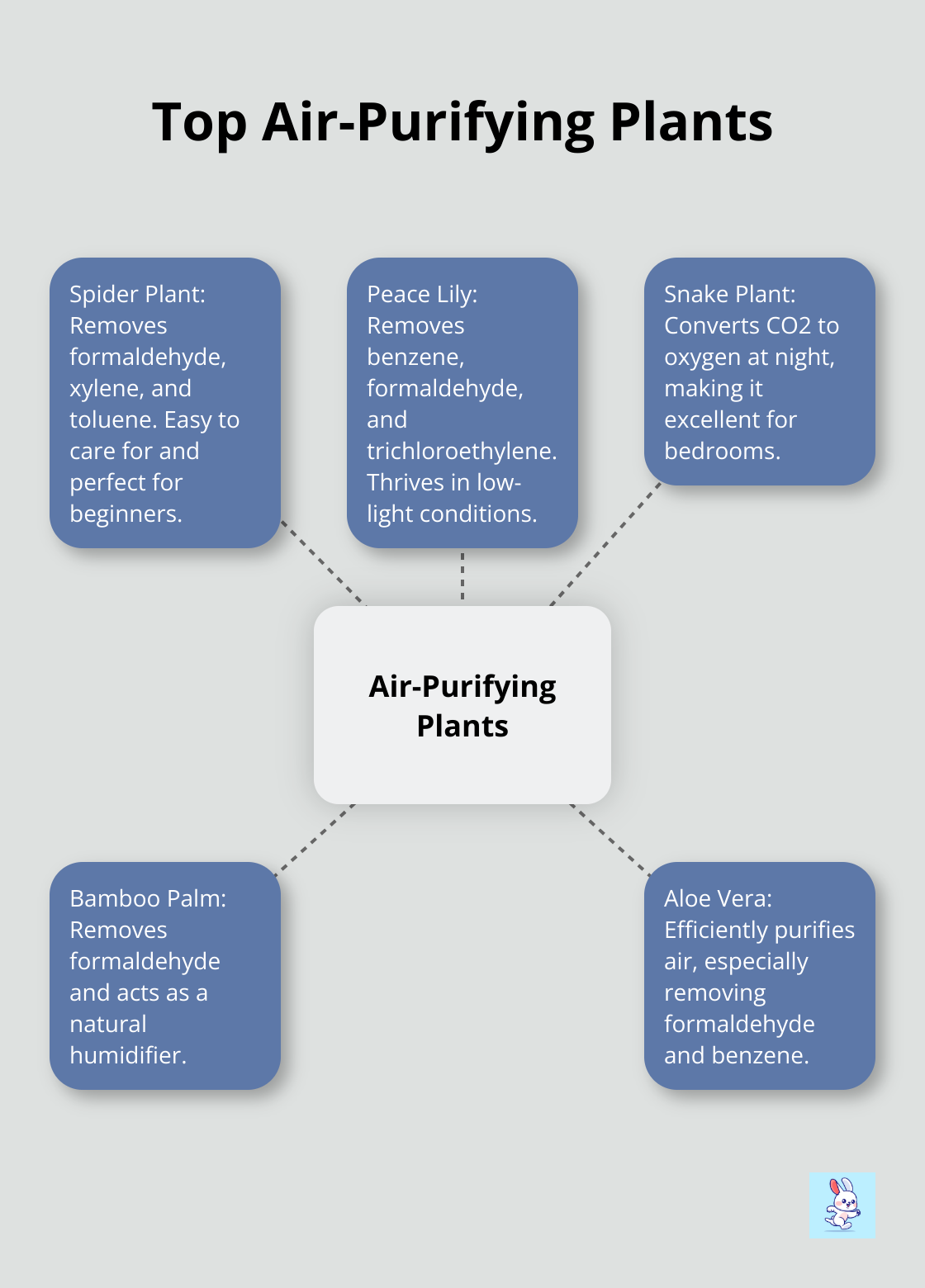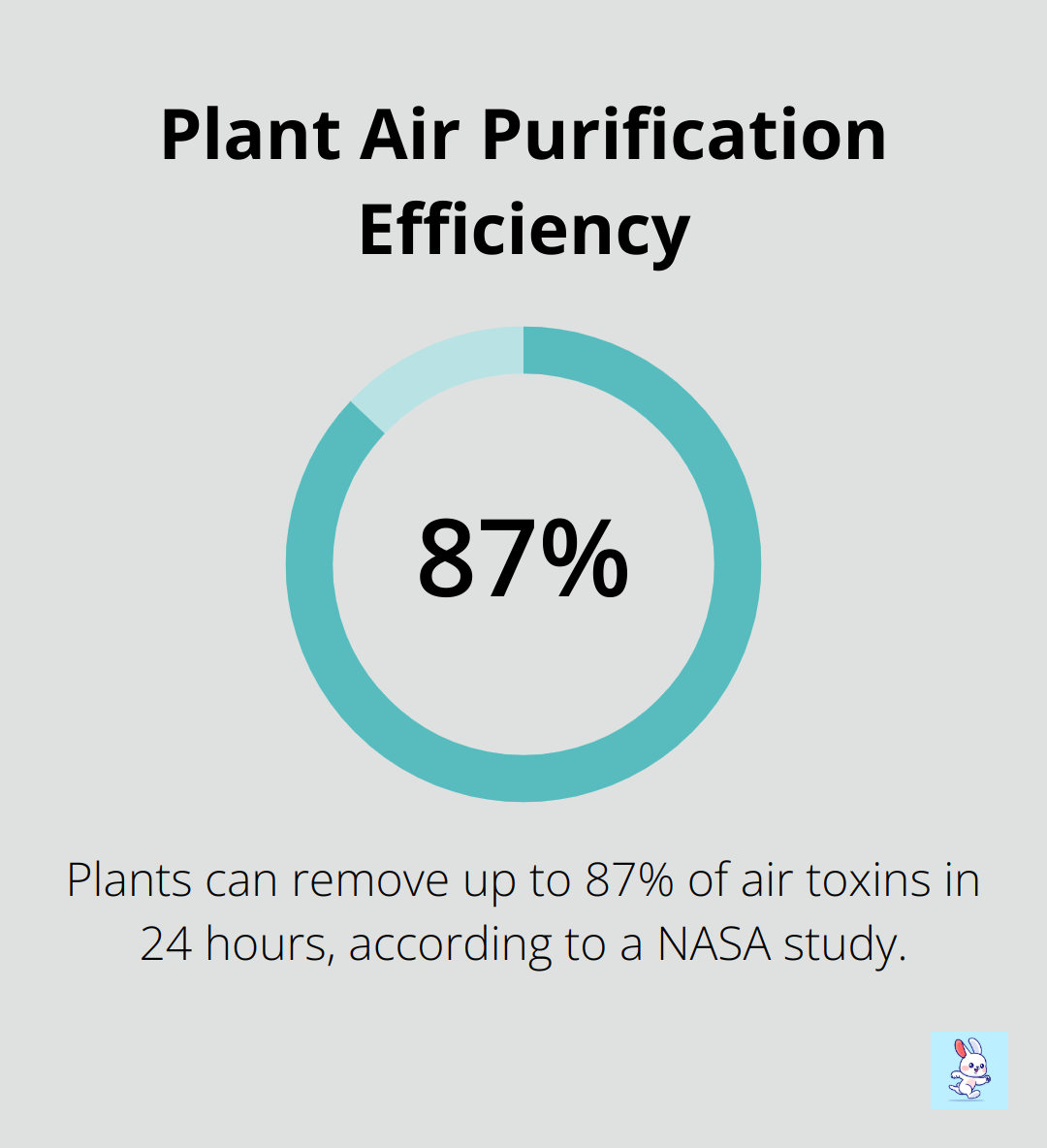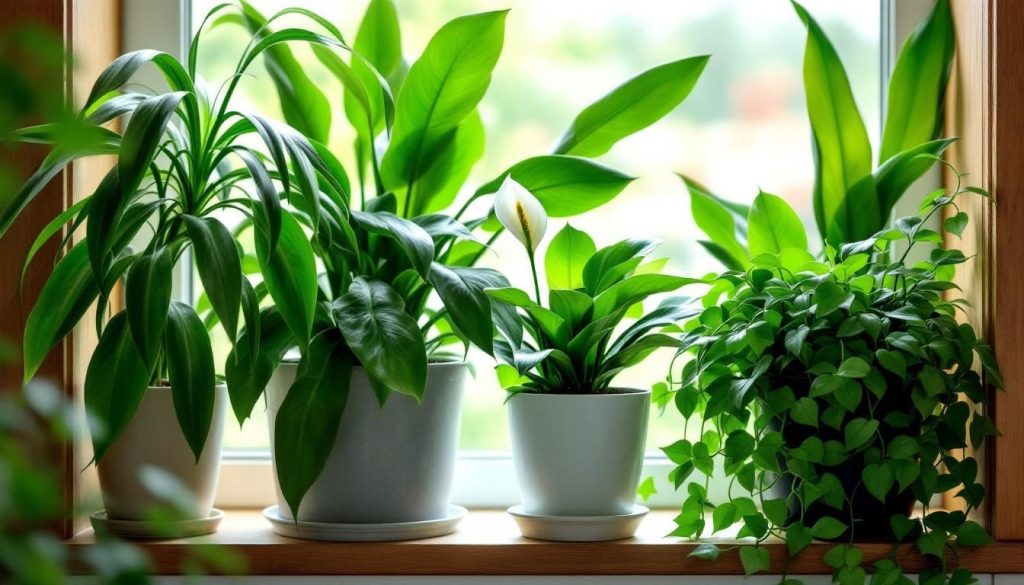Indoor plants offer more than just aesthetic appeal. They’re natural air purifiers, capable of removing toxins and improving the quality of the air we breathe.
At Cleaning Rabbit, we’ve researched the best indoor plants for clean air and their numerous benefits. In this post, we’ll explore the top air-purifying plants, how they work, and how to care for them effectively.
Which Plants Clean Air Best?
Indoor plants aren’t just pretty decorations. They act as natural air purifiers that can significantly improve the quality of the air in your home or office. Let’s explore some of the most effective air-purifying plants you can add to your space.
Spider Plant: The Resilient Air Cleaner
The Spider Plant (Chlorophytum comosum) stands out as a powerhouse for air purification. It is known for its ability to remove formaldehyde, xylene, and toluene from the air. This hardy plant also proves incredibly easy to care for, making it perfect for beginners or busy individuals.
Peace Lily: Beauty and Function Combined
Peace Lilies (Spathiphyllum) offer visual appeal and high effectiveness in removing common indoor pollutants. They may provide a natural way of removing volatile organic pollutants such as benzene, formaldehyde, and trichloroethylene. They thrive in low-light conditions, making them ideal for offices or rooms with limited natural light.
Snake Plant: The Bedroom Air Purifier
The Snake Plant (Sansevieria trifasciata), also known as Mother-in-Law’s Tongue, converts carbon dioxide into oxygen at night. This unique ability makes it an excellent choice for bedrooms.
Bamboo Palm: The Humidity Regulator
Bamboo Palms (Chamaedorea seifrizii) excel at removing formaldehyde and act as natural humidifiers. This plant proves particularly beneficial in dry climates or during winter when indoor air tends to be drier.
Aloe Vera: The Multitasking Air Purifier
Aloe Vera (Aloe barbadensis miller) does more than soothe sunburns. It efficiently purifies air, especially in removing formaldehyde and benzene.
When selecting air-purifying plants, consider your specific needs and the conditions of your space. While these plants effectively purify air, they work best in conjunction with other air quality management strategies. Try combining the use of air-purifying plants with regular air duct cleaning and HVAC maintenance for optimal indoor air quality.

Now that we’ve covered the best plants for air purification, let’s explore how these green wonders actually improve air quality in our homes and offices.
How Plants Clean Indoor Air
Nature’s Filtration System
Plants act as natural air filters. Their leaves absorb airborne pollutants through tiny pores called stomata. Once inside the leaf, the plant’s natural processes break down these toxins. A NASA study found that plants can remove up to 87% of air toxins in 24 hours.

Oxygen Production Through Photosynthesis
During photosynthesis, plants convert carbon dioxide into oxygen. This process removes CO2 from the air and increases oxygen levels. The Snake Plant (also known as Mother-in-Law’s Tongue) excels at this process at night, which makes it an excellent choice for bedrooms.
Humidity Regulation
Plants release water vapor through transpiration, which can increase humidity levels in dry indoor environments. The Bamboo Palm performs particularly well in this aspect. Proper humidity levels (between 30-50%) can reduce the risk of respiratory issues and skin irritation.
Dust Reduction
Plants with large, waxy leaves (such as rubber plants or peace lilies) can trap dust particles, effectively reducing airborne dust in your home. Regular cleaning of plant leaves enhances this dust-trapping ability.
Volatile Organic Compound (VOC) Removal
Plants can remove toxicants from air, soil, and water in at least two ways. First, they can metabolize some toxic chemicals, releasing harmless by-products. Many indoor plants excel at removing VOCs from the air. These compounds, often found in paints, furniture, and cleaning products, can cause health issues. Spider plants and peace lilies are particularly effective at removing formaldehyde, while snake plants target benzene and trichloroethylene.
The effectiveness of plants in purifying air depends on factors like the number of plants, their size, and the air flow in your space. Try to place one medium to large-sized plant per 100 square feet of indoor space for optimal results.
While plants work wonders for air quality, they’re most effective when part of a comprehensive air quality strategy. Combining air-purifying plants with regular HVAC maintenance can significantly improve your indoor air. In the next section, we’ll explore how to care for these natural air purifiers to ensure they continue to clean your air effectively.
How to Care for Air-Purifying Plants
Watering Techniques
Water your air-purifying plants only when the top inch of soil feels dry. Spider plants and snake plants tolerate drought well, requiring water every 1-2 weeks. Peace lilies prefer consistently moist soil. Use room temperature water and avoid wetting the leaves to prevent fungal growth.
Light Requirements
Many air-purifying plants tolerate low light, but they perform best with proper illumination. Snake plants and peace lilies thrive in indirect light (perfect for offices or bedrooms). Spider plants and bamboo palms prefer bright, indirect light. Aloe vera needs direct sunlight for at least six hours daily. Rotate your plants quarterly to ensure even growth and light exposure.

Soil and Nutrition
Use a well-draining potting mix for most air-purifying plants. A combination of peat, perlite, and vermiculite works well. Fertilize monthly during the growing season (spring and summer) with a balanced, water-soluble fertilizer diluted to half strength. Avoid over-fertilizing as it can lead to salt build-up, which damages roots and reduces air-purifying efficiency.
Pest Control
Inspect leaves regularly for signs of infestation (such as sticky residue, webbing, or discoloration). If you spot pests, isolate the affected plant and treat it with neem oil or insecticidal soap. For severe infestations, replace the plant to prevent spread to others.
Maintenance Tips
Clean plant leaves regularly to remove dust and maximize their air-purifying abilities. Try to place one medium to large-sized plant per 100 square feet of indoor space for optimal results. Prune your plants as needed to maintain their shape and remove any dead or yellowing leaves. While plants can help remove contaminants, regular cleaning and proper ventilation are also essential for maintaining clean indoor air.
Final Thoughts
Indoor plants offer natural air purification for homes and offices. The Spider Plant, Peace Lily, Snake Plant, Bamboo Palm, and Aloe Vera excel at removing toxins and improving air quality. These green companions also provide additional benefits for indoor spaces, such as stress reduction and increased productivity.
We encourage you to start your own indoor garden for cleaner air. The care for these plants is relatively simple, but you must provide appropriate light, water, and nutrition to maximize their air-cleaning potential. Indoor plants benefits extend beyond air purification, significantly improving overall well-being and quality of life.
For professional air duct cleaning, HVAC sanitation, and air quality assessments, consider Cleaning Rabbit. We use advanced HEPA-filtered equipment to ensure your indoor air is clean and healthy. You can create a healthier, more comfortable living environment by combining air-purifying plants with professional air quality services.

